 To enhance service speed and avoid tariff delays, we've opened a US warehouse. All US orders ship directly from our US facility.
To enhance service speed and avoid tariff delays, we've opened a US warehouse. All US orders ship directly from our US facility.
| Cat. No. | Product Name | Field of Application | Chemical Structure |
|---|---|---|---|
| DC65028 | 4-(((1r,4r)-4-aminocyclohexyl)oxy)-2-chlorobenzonitrile hydrochloride Featured |
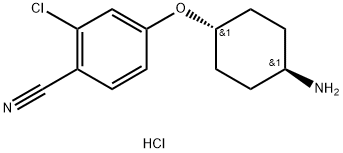
|
|
| DCC3505 | Mßl-in-2i Featured |
Novel potent broad-spectrum metallo-β-lactamase (MβL) inhibitor, inhibiting the MβLs NDM-1, VIM-2, ImiS, and L1
More description
|

|
| DCC5399 | Ver-246608 Featured |
Novel pan-isoform ATP competitive inhibitor of pyruvate dehydrogenase kinase, disrupting Warburg metabolism and inducing context-dependent cytostasis in cancer cells
More description
|
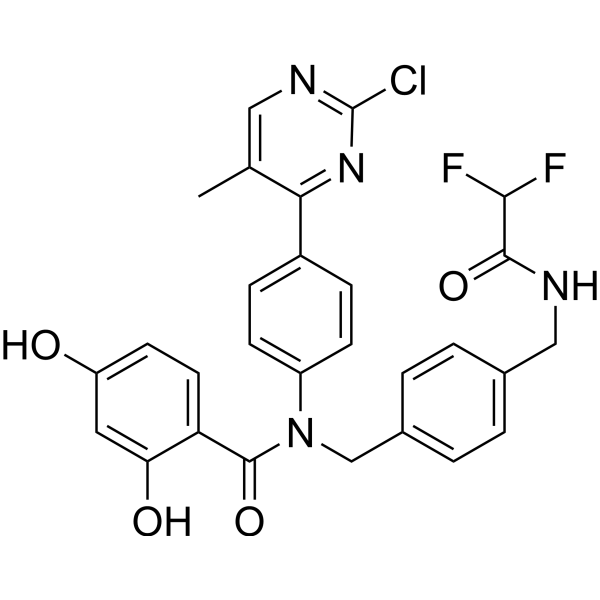
|
| DC49572 | (R)-AM-5308 Featured |
AM-5308 is a potent and selective KIF18A inhibitor with demonstrated antitumor activity in cell-based and animal models. Its ability to disrupt mitosis and induce cancer cell death makes it a promising candidate for further development as a cancer therapeutic.
More description
|

|
| DC9764 | Afoxolaner Featured |
Afoxolaner is an isoxazoline that inhibits insect and acarine ligand-gated chloride channels, in particular those gated by the neurotransmitter gamma-aminobutyric acid (GABA), blocking pre and post synaptic transfer of chloride ions across cell membranes.
More description
|

|
| DC67028 | Pegaptanib Featured |

|
|
| DC47290 | Remlarsen Featured |
Remlarsen (MRG-201), a miR-29b mimic, acts a miR-29b agonist. Remlarsen has the potential for preventiong formation of a fibrotic scar or cutaneous fibrosis.
More description
|

|
| DC9703 | CHIR-99021 HCl Featured |
CHIR-99021 HCl is a potent and selective inhibitor of glycogen synthase kinase 3 beta (GSK-3β), a key enzyme involved in regulating various cellular processes, including metabolism, cell proliferation, and differentiation. By inhibiting GSK-3β, CHIR-99021 HCl modulates downstream signaling pathways, particularly the Wnt/β-catenin pathway, leading to significant biological effects both in vitro and in vivo.
More description
|

|
| DC23985 | Laduviglusib trihydrochloride Featured |
Laduviglusib (CHIR-99021) trihydrochloride is a well-characterized small molecule inhibitor that specifically targets glycogen synthase kinase-3 alpha and beta (GSK-3α/β). It exhibits potent inhibitory activity with IC50 values of 10 nM for GSK-3α and 6.7 nM for GSK-3β. Importantly, it demonstrates high selectivity, being over 500-fold more selective for GSK-3 compared to other kinases such as CDC2 and ERK2, as well as a broad range of other protein kinases.
More description
|
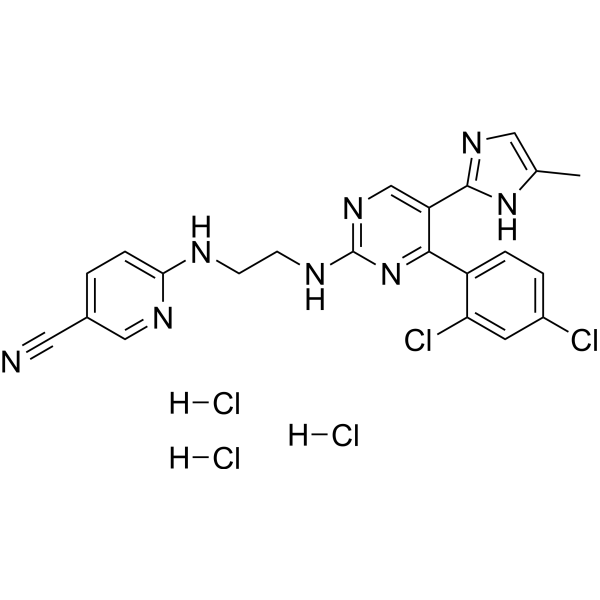
|
| DC67275 | VU0364739 Featured |
VU0364739 is a selective inhibitor of phospholipase D2 (PLD2) with an IC50 value of 22 nM. Phospholipase D (PLD) enzymes, including PLD1 and PLD2, are involved in various cellular processes, such as signal transduction, membrane trafficking, and cytoskeletal reorganization. PLD2, in particular, has been implicated in cancer cell proliferation, survival, and metastasis, making it a potential target for anticancer therapies.
More description
|
.gif)
|
| DC65715 | VU 0364739 hydrochloride Featured |
VU0364739 is a selective PLD2 inhibitor (IC50: 22 nM). VU0364739 decreases cancer cell proliferation.
More description
|
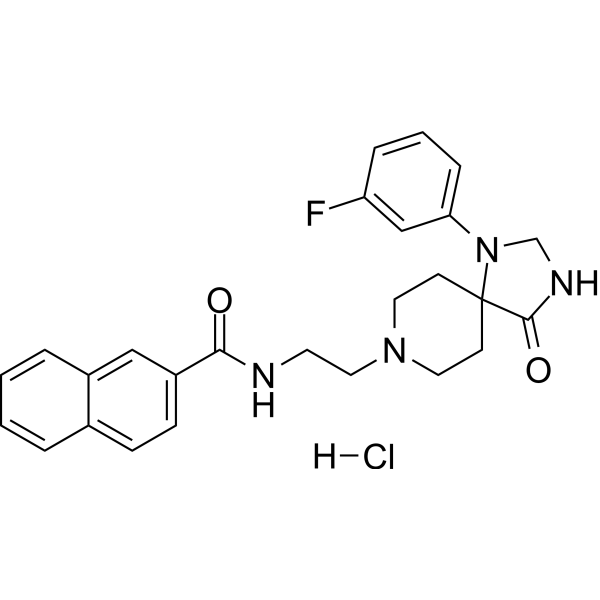
|
| DC20083 | H-Ile-Pro-Pro-OH Featured |
H-Ile-Pro-Pro-OH, a milk-derived peptide, inhibits angiotensin-converting enzyme (ACE) with an IC50 of 5 μM. Antihypertensive tripeptides.
More description
|
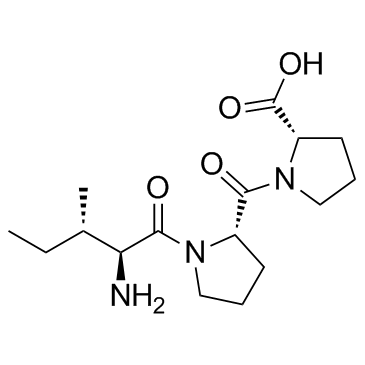
|
| DC40211 | H-Ile-Pro-Pro-OH hydrochloride Featured |
H-Ile-Pro-Pro-OH hydrochloride, a milk-derived peptide, inhibits angiotensin-converting enzyme (ACE) with an IC50 of 5 μM. Antihypertensive tripeptides.
More description
|

|
| DC73988 | EP055 Featured |
EP055 (EP-055) is a small molecule that targets EPPIN on the surface of sperm and inhibits motility (IC50=199.5 uM, CASA assay using human sperm), binds to the C-terminal domain of EPPIN.
More description
|
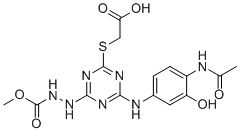
|
| DC42455 | Acetylene-linker-Val-Cit-PABC-MMAE Featured |
Acetylene-linker-Val-Cit-PABC-MMAE (LCB14-0602) consists the ADCs linker (Acetylene-linker-Val-Cit-PABC) and potent tubulin (MMAE). Acetylene-linker-Val-Cit-PABC-MMAE (LCB14-0602) is a drug-linker conjugate for ADC.
More description
|

|
| DC71950 | Ac-Lys-Val-Cit-PABC-MMAE Featured |
Ac-Lys-Val-Cit-PABC-MMAE is a drug-linker conjugate for ADC. Ac-Lys-Val-Cit-PABC-MMAE contains the ADC linker (peptide Ac-Lys-Val-Cit-PABC) and a potent tubulin polymerization inhibitor MMAE.
More description
|

|
| DC49346 | Bi-Mc-VC-PAB-MMAE Featured |
Bi-Mc-VC-PAB-MMAE consists ADCs linker (Fmoc-Val-Cit-PAB) and potent tubulin inhibitor (MMAE). Bi-Mc-VC-PAB-MMAE is a drug-linker conjugate for ADC.
More description
|

|
| DC47680 | PSMA-Val-Cit-PAB-MMAE Featured |
PSMA-Val-Cit-PAB-MMAE is a novel small-molecule PSMA-targeted conjugate based on the monomethyl auristatin E for the chemotherapy of prostate cancer.
More description
|

|
| DC74540 | MTX-3937 Featured |
MTX-3937 is a small-molecule inhibitor targeting Siglec-9 (Sialic acid-binding immunoglobulin-type lectin-9), a member of the Siglec family of immunomodulatory receptors. Siglec-9 is primarily expressed on immune cells, such as myeloid cells and natural killer (NK) cells, and plays a role in regulating immune responses by transmitting inhibitory signals through its intracellular immunoreceptor tyrosine-based inhibitory motifs (ITIMs).
More description
|
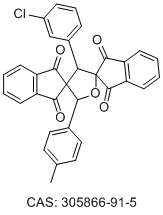
|
| DC60780 | TH7126 Featured |
TH7126 is an inactive control of TH6342. TH7126 does not disrupt SAMHD1 dimerization.
More description
|
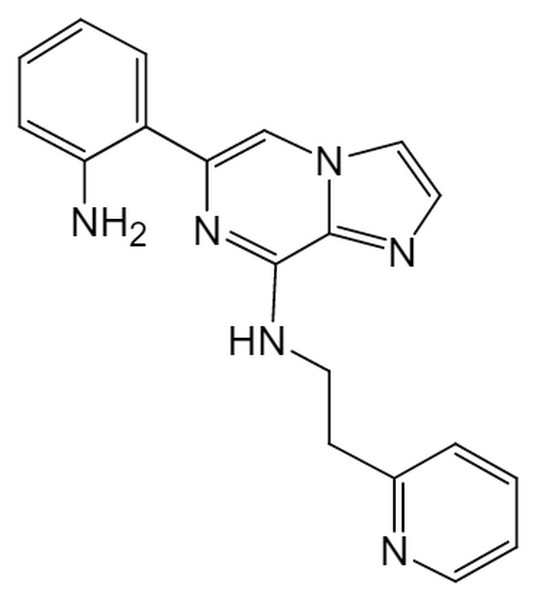
|
| DC60779 | TH7127 Featured |
TH7127 is a SAMHD1 inhibitor with IC50 of 4.9 μM/4.5 μM/4.0 μM against dGTP/Cl-F-ara-ATP/ara-CTP, respectively.
More description
|
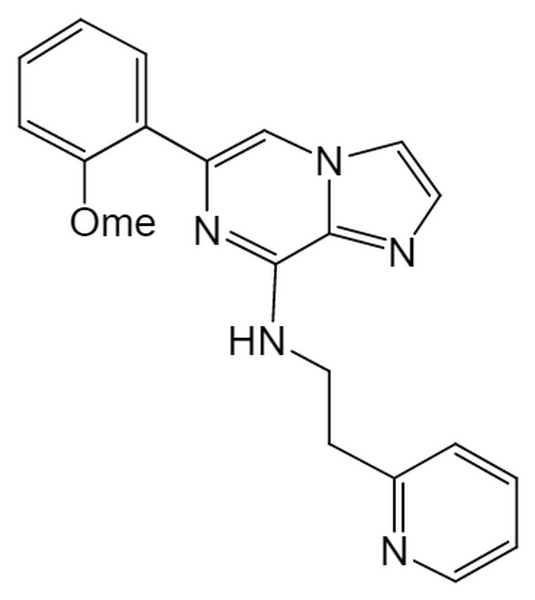
|
| DC73210 | TH7528 Featured |
TH7528 is a SAMHD1 inhibitor with IC50 of 4.5 μM/2.8 μM/2.6 μM against dGTP/Cl-F-ara-ATP/ara-CTP, respectively.
More description
|
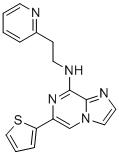
|
| DC60778 | TH6342 Featured |
TH6342 is a SAMHD1 inhibitor with IC50 of 9.1 μM/11.0 μM/5.8 μM against dGTP/Cl-F-ara-ATP/ara-CTP, respectively. TH6342 engages pre-tetrameric SAMHD1 and deter oligomerization and allosteric activation without occupying nucleotide-binding pockets.
More description
|
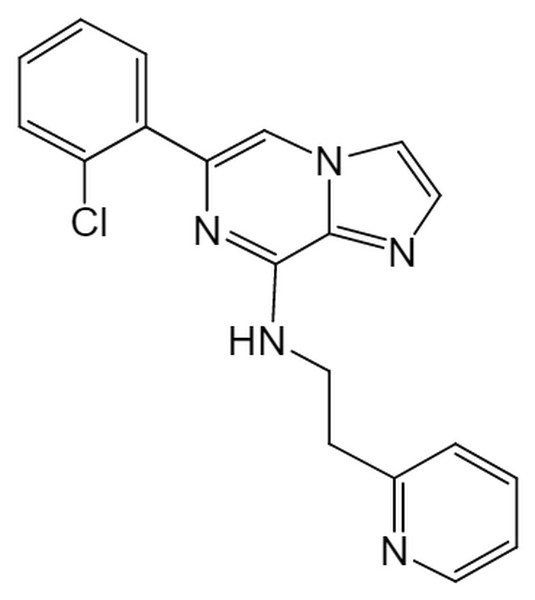
|
| DC12262 | H-Val-Pro-Pro-OH TFA Featured |
H-Val-Pro-Pro-OH (TFA) is a trifluoroacetate (TFA) salt form of the tripeptide H-Val-Pro-Pro-OH, which is derived from milk proteins. This peptide is known for its ability to inhibit Angiotensin I Converting Enzyme (ACE), a key enzyme in the renin-angiotensin system (RAS) that regulates blood pressure. The TFA salt form is commonly used in research and pharmaceutical applications to improve the solubility and stability of the peptide.
More description
|

|
| DC20081 | H-Val-Pro-Pro-OH Featured |
H-Val-Pro-Pro-OH is a tripeptide derived from milk proteins, specifically a proline-rich peptide, and is known for its inhibitory activity against Angiotensin I Converting Enzyme (ACE). ACE is a key enzyme in the renin-angiotensin system (RAS), which regulates blood pressure by converting angiotensin I to angiotensin II, a potent vasoconstrictor. Inhibition of ACE leads to reduced angiotensin II levels, resulting in vasodilation and lowered blood pressure.
More description
|
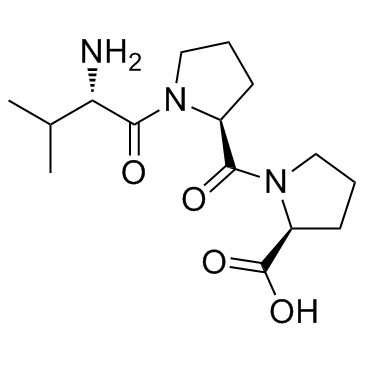
|
| DC60279 | ART812 Featured |
ART-812 is a potent inhibitor of DNA polymerase Polθ (also known as Pol theta or POLQ), with an IC50 value of 7.6 nM. This indicates that ART-812 effectively inhibits the enzymatic activity of Polθ at low nanomolar concentrations. Polθ is a key enzyme involved in the microhomology-mediated end joining (MMEJ) pathway, which is an error-prone DNA repair mechanism.
More description
|
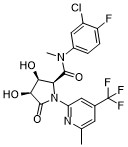
|
| DC9482 | 17-AAG Featured |
17-AAG (17-N-Allylamino-17-demethoxygeldanamycin), also known by its NSC number 330507 and CP number 127374, is a well-studied inhibitor of Heat Shock Protein 90 (HSP90). HSP90 is a molecular chaperone that plays a critical role in the stabilization and activation of a wide range of client proteins, many of which are involved in oncogenic processes. By inhibiting HSP90, 17-AAG disrupts the function of these client proteins, leading to the degradation of oncogenic proteins and ultimately inhibiting cancer cell growth and survival.
More description
|

|
| DC72871 | FHP01 Featured |
FHP01 (BA103) is a potent, small molecule inhibitor of DDX3X helicase activity with IC50 of 0.3 uM in in vitro enzyme assays, exhibits very effective antiproliferative and killing activity against different breast cancer cell types (IC50=3.058 and 3.21 μM in MDA MB 468 and MDA MB 231, respectively).
FHP01 does not inhibit the ATPase activity of DDX3X and the helicase activity of DDX1 (IC50>100 uM).
FHP01 also inhibited WNT signaling, a key tumorigenic pathway already correlated to DDX3X functions in breast cancer model cell lines.
FHP01 inhibits ER+/PR+ (IC50 = 12.43 and 10.62 μM in MCF7 and T47D cells, respectively) and HER2+ (IC50 = 13.46 μM in SKBR3) cells, but lower in control MCF10A cells (IC50 = 28.71 μM).
FHP01 (45 mg/kg, i.p. injection) suppresses rowth of MDA MB 231 tumor xenografts in nude mice.
More description
|
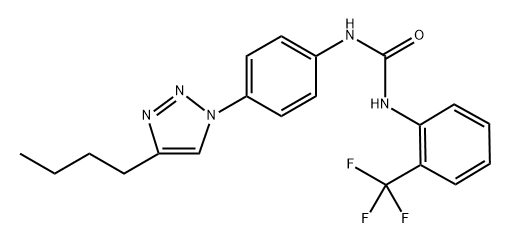
|
| DC72877 | PF-114 Featured |
Vamotinib (PF-114) is a potent, selective and orally available inhibitor of native (IC50=0.49 nM) and mutated BCR/ABL (IC50=0.7-4 nM, ABL (T315I) IC50=0.78 nM). PF-114 potently inhibits ABL2, DDR1, DDR2, FMS, FRK, LCK, LYN and PDGFR kinases, but did not inhibit c-SRC, CSK, or c-KIT.
More description
|

|
| DC74017 | HTL0041178 Featured |
HTL0041178 is a potent GPR52 agonist with EC50 of 27.5 nM (human or rat GPR52).
More description
|
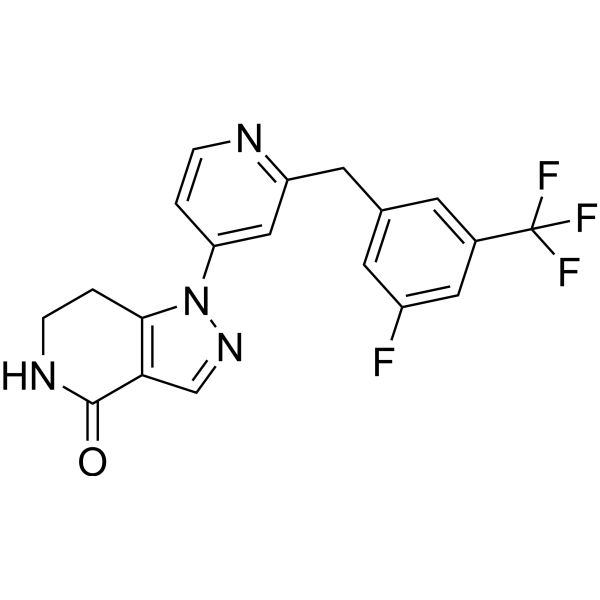
|